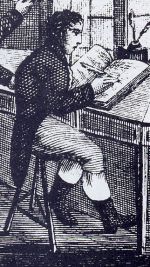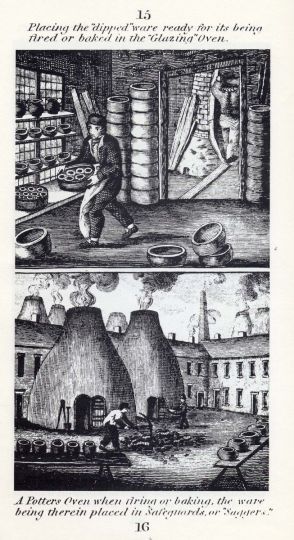Working Conditions in the Potteries
|
Through questionnaires, site visits, and personal interviews, Scriven and his team investigated working conditions including those in coal mines, cotton and woolen mills, and pottery factories. As a result of the investigation Parliament passed legislation controlling the hours and conditions of work for young people. Unlike the coal mines and textile mills, the Staffordshire potteries were not named in the subsequent acts perhaps because, despite what seemed like a hard life to us, the average pottery factory offered working conditions better than the minimum required by the new law. After interviewing many witnesses and recording the minutiae of daily life of factory workers--including food, light, temperature, wages, education, supervision, and leisure time--Scriven reported that though he had intended to inspect each factory, there were so many and there were great similarities that he chose to divide them into three classes, “not according to their magnitude or extent but to their merits as to drainage, ventilation and convenience” , that is according to the merits of the physical working conditions. Local clergymen and medical practitioners offered their testimony to the Commission, which Scriven appended to his report. The report noted several potential dangers for child workers. Separating children and adult workers by gender greatly concerned the commissioners. The report confirmed that children began to work in the potteries at an early age. Often adults working in the pottery employed them rather than the factory owner. Click here to read the full text of The Report to Her Majesties Commissioners on the Employment of Children and Young Persons in the District of the STAFFORDSHIRE POTTERIES; and on the actual State, Condition, and Treatment of such Children and Young Persons by Samuel Scriven Esq., 1841 |
|

 Samuel Scriven arrived in The Potteries in December 1840 to conduct a government commissioned inspection on the employment of children in potteries. He finished his investigation by late February and submitted his report in March of 1841. Copeland and Garrett took over the Spode factory four years before Scriven began his study, but many of the workers interviewed as adults had begun to work there when it was owned by the Spodes. Their descriptions of the factory and working conditions were undoubtedly similar to those experienced in Spode’s time.
Samuel Scriven arrived in The Potteries in December 1840 to conduct a government commissioned inspection on the employment of children in potteries. He finished his investigation by late February and submitted his report in March of 1841. Copeland and Garrett took over the Spode factory four years before Scriven began his study, but many of the workers interviewed as adults had begun to work there when it was owned by the Spodes. Their descriptions of the factory and working conditions were undoubtedly similar to those experienced in Spode’s time.